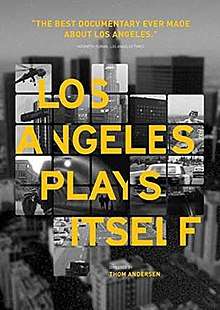Los Angeles Plays Itself
Los Angeles Plays Itself is a video essay by Thom Andersen, finished in 2003, exploring the way Los Angeles has been presented in movies.[2][3] Consisting almost entirely of clips from other films with narration, the film was not initially released commercially as it was only seen in screenings presented by Andersen, occasional presentations at American Cinematheque and copies distributed via filesharing and other person-to-person methods. In 2014, it was announced that the film would finally be released officially by Cinema Guild.[4][5][6] [7] [8]
| Los Angeles Plays Itself | |
|---|---|
 | |
| Directed by | Thom Andersen |
| Written by | Thom Andersen |
| Starring | Encke King (narrator) |
| Cinematography | Deborah Stratman |
| Edited by | Seung-Hyun Yoo |
Release date |
|
Running time | 169 minutes [1] |
| Country | USA |
| Language | English |
Inspiration
Andersen stated that the film idea occurred to him after a lecture he gave at the California Institute of the Arts, where he talked about his objections to L.A. Confidential, the 1997 Curtis Hanson film adapted from James Ellroy's novel.[9]
Synopsis
In the film, Andersen argues that the influence of Hollywood overshadows Los Angeles and is one of the reasons the city's name is frequently abbreviated.[9] He makes the case that directors have a distaste for modernist architecture, which is regularly used for villain's homes.[9]
Reception
On review aggregator website Rotten Tomatoes, the film has an approval rating of 96% based on 45 reviews, with an average rating of 8.2/10. The site's critical consensus reads, "A treat for cinephiles, this documentary is a comprehensive, academic, and enlightening film essay concerning Los Angeles and its depiction in the movies."[10] On Metacritic, the film has a weighted average score of 86 out of 100, based on 19 critics, indicating "universal acclaim".[11]
The film won the National Film Board Award for Best Documentary at the 2003 Vancouver International Film Festival and was voted best documentary of 2004 by the Village Voice Critic's Poll. [12]
References
- Senses of Cinema
- Variety
- Interview with Thom Andersen on WNYC Radio
- Thom Andersen’s Los Angeles Plays Itself is finally coming to home video/The Dissolve
- The Reality of Film; Thom Anderson on Los Angeles Plays Itself
- Bringing It Back: An Interview With Thom Andersen
- Urban Renewal:The dreamlife of Angeles: A film professor reclaims his city
- Thom Andersen interview with StopSmiling Magazine
- SCOTT FOUNDAS (July 25, 2004). "FILM; L.A. Residential". NY Times. Retrieved March 5, 2015.
- "Los Angeles Plays Itself". Rotten Tomatoes. Retrieved November 17, 2018.
- "Los Angeles Plays Itself". Metacritic. Retrieved November 17, 2018.
- MUBI